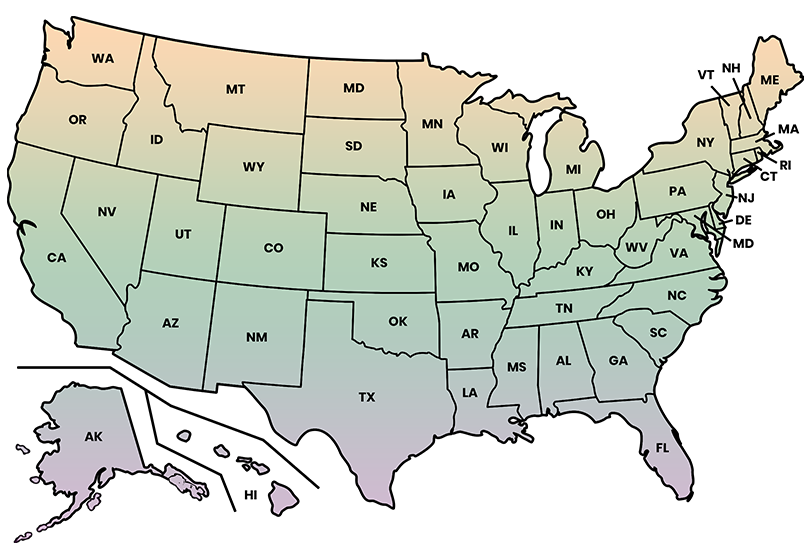Welcome to our comprehensive guide on the Federal Unemployment Tax Act (FUTA) and what it means for your business. As employers, it's crucial to follow federal regulations, and FUTA is a key part of handling payroll taxes properly. Understanding FUTA is essential for managing taxes well, so it's important for every employer to know its requirements.
- What is FUTA?
- FUTA vs SUTA
- Who must pay FUTA?
- FUTA Tax Rates and Wage Limits for 2024 and 2025:
- FUTA credit reduction states 2025
- How to calculate FUTA Tax
- Filing Requirements
- FUTA Tax Deposits
- Simple solution for managing employee wages and taxes, including FUTA?
What is FUTA?
The Federal Unemployment Tax Act (FUTA) is a federal law that requires employers to pay unemployment taxes to provide funds for unemployment compensation to workers who have lost their jobs. The Federal Unemployment Tax Act is separate from state unemployment insurance (SUI) taxes, and it is solely a federal tax.
FUTA vs SUTA
Understanding the difference between FUTA (Federal Unemployment Tax Act) and SUTA (State Unemployment Tax Act) is crucial. Although both taxes support unemployment benefits, they have distinct roles and are managed separately. FUTA is a federal tax, while SUTA is imposed by individual states. Employers need to adhere to the requirements of both FUTA and SUTA.
Who must pay FUTA?
Most employers subject to FUTA are obligated to pay for unemployment taxes if they meet any of the following criteria:
- Paid wages of $1,500 or more to employees in any calendar quarter during the current or preceding calendar year.
- Employed one or more employees for at least some part of a day in any 20 or more different weeks in the current or preceding calendar year.
FUTA Tax Rates and Wage Limits for 2024 and 2025
The FUTA tax rate for 2024 and 2025 stands at 6.0%, applicable to the initial $7,000 of wages paid to each employee annually, termed as the federal or FUTA wage base.
State Conformity and Credits
Federal and state unemployment taxes work together through credits and offsets. Employers get a credit against their FUTA tax by contributing to state unemployment programs. But if a state fails to repay federal loans for unemployment benefits, it could become a credit reduction state, leading to higher FUTA taxes for its employers. Normally, employers can receive up to a 5.4% credit against their FUTA tax by paying state unemployment taxes on time. However, in credit reduction states with outstanding federal loans, this credit may be reduced or eliminated, resulting in a higher net FUTA tax rate, potentially exceeding 0.6%.
FUTA credit reduction states 2025
Four states had an outstanding Title XII advance balance as of January 1, 2025. Employers in these states may face a potential reduction in FUTA credit on their IRS Form 940 for 2025 if the outstanding advance is not repaid by November 10, 2025.
| State | 2025 Potential Credit Reduction Due to Outstanding Advance | 2025 Potential "2.7 add-on " | 2025 Estimated "BCR add-on " | 2025 Potential Total Credit Reduction |
|---|---|---|---|---|
| California | 1.2% | 0.0% | 3.7% | 4.9% |
| Connecticut | 1.2% | 0.0% | 0.8% | 2.0% |
| New York | 1.2% | 0.0% | 1.1% | 2.3% |
| Virgin Islands | 4.5% | 0.0% | 0.0% | 4.5% |
How to calculate FUTA Tax
The current FUTA tax rate is 6.0% on the first $7,000 of wages paid to each employee during a calendar year. However, most employers receive a credit of up to 5.4% when they pay state unemployment taxes, effectively making the FUTA tax rate 0.6% (6.0% - 5.4%).
How you can calculate FUTA tax for an employee:
- If the employee's annual wage is more than $7,000, only the first $7,000 is subject to FUTA tax.
- If the employee's annual wage is $7,000 or less, the entire amount is subject to FUTA tax.
- FUTA tax = Taxable wages * FUTA tax rate
For example:
- Assume you have two employees, Employee A and Employee B.
- Employee A earns $9,000 annually and
- Employee B earns $5,000 annually.
- Determine taxable wages for each employee:
- Employee A's taxable wages: $7,000 (maximum taxable amount)
- Employee B's taxable wages: $5,000 (full amount since it's below $7,000)
Calculate the FUTA tax for each employee:
Employee A:
FUTA tax = $7,000 * 0.006 (FUTA tax rate with credit reduction)= $42
Employee B:
FUTA tax = $5,000 * 0.006 (FUTA tax rate with credit reduction)= $30
Total FUTA tax:
Total FUTA tax = FUTA tax for Employee A + FUTA tax for Employee B = $42 + $30 = $72
If an employer is not eligible for the FUTA credit reduction, they would be subject to the FUTA tax rate of 6.0% on the initial $7,000 of wages paid to each employee throughout a calendar year.
Here's the same example without any credit reduction:
Employee A:
FUTA tax = $7,000 * 6.0% (FUTA tax rate without credit reduction)= $420
Employee B:
FUTA tax = $5,000 * 6.0% (FUTA tax rate without credit reduction)= $300
Total FUTA tax:
Total FUTA tax = FUTA tax for Employee A + FUTA tax for Employee B = $420 + $300 = $720
Remember, this is just a basic example. The actual calculation may vary based on specific circumstances, such as different FUTA tax rates for certain states, various credits, or exemptions.
Filing Requirements:
To fulfill filing requirements, employers need to submit Form 940, the Employer's Annual Federal Unemployment (FUTA) Tax Return, annually by January 31 of the following year.
Electronic filing options are available for faster and more convenient processing. Employers looking to file Form 940 and avoid penalties for late or non-filing can use taxzerone.com.
FUTA Tax Deposits
For Form 940, quarterly deposits are necessary if your FUTA tax liability exceeds $500 for the year. If your liability is $500 or less in a quarter, carry it forward. Once the cumulative liability surpasses $500, deposit by the last day of the month after the quarter. For the fourth quarter, if your liability remains $500 or less, you can pay it with Form 940 by January 31. Deposits on non-business days are considered timely the next business day. When your quarterly liability exceeds $500, electronic funds transfer is required. In years with credit reduction states, include liabilities in the fourth quarter deposit.
| Reporting Period | Due Date |
|---|---|
| Quarter 1 | April 30 |
| Quarter 2 | July 31 |
| Quarter 3 | October 31 |
| Quarter 4 | January 31 |
Simple solution for managing employee wages and taxes, including FUTA?
As a leading paystub generator, SecurePayStubs can assist you in accurately calculating employee wages and taxes, including FUTA. Our platform provides customizable free paystub templates that include all necessary tax deductions, ensuring compliance with federal regulations.
This article has been updated from its original publication date of March 10, 2025.




